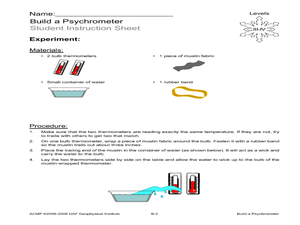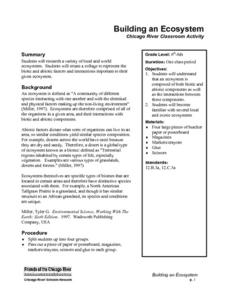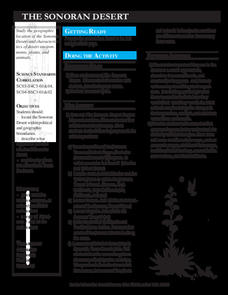Curated OER
What is the history of rice in the United States?
Fifth graders become familiar with the history of rice and create a board game. In this rice lesson, 5th graders understand the history of rice through the playing of a game. Students use vocabulary words related to the...
Curated OER
Elements of Civilization
Students create their own ancient civilizations based off of topographical maps of Egypt, Mesopotamia, the Indus Valley, and the Yellow River. In this social studies lesson, students are assigned one topographical map to use to create...
Curated OER
Build a Psychrometer
Students understand that a psychrometer is a weather instrument used to detect humidity. In this psychrometer lesson, students build a psychrometer. Students use their psychrometers to measure humidity activity.
Curated OER
Pass the Jug
Students discuss water rights. In this science lesson, students simulate an exercise whereby they begin to understand the meaning of water allocation and limited water supplies by actually passing out water from a jug.
Curated OER
Causes of the Civil War: Missouri Compromise, Compromise of 1850 and Kansas Nebraska Act
How did the Missouri Compromise, the Compromise of 1850, and the Kansas-Nebraska Act contribute to the growing tensions that led to the Civil war? To better understand the events that led to the Civil War, young historians engage in a...
Curated OER
Building an Ecosystem
Young scholars research a variety of local and world ecosystems. Students will create a collage to represent the biotic and abiotic factors and interactions important to their given ecosystem.Young scholars will understand that an...
Curated OER
Taking the Mystery Out of Mesopotamia
Students locate Mesopotamia on the map and explain the importance of its location. In this Mesopotamia lesson, students understand why the new discoveries of Mesopotamia were so important to civilization. Students participate in...
Curated OER
Africa Review
Seventh graders trace the major events in African history. In this social studies lesson students, create a flowchart depicting the things they learned during this lesson. Students understand the chronology of major events that took...
Curated OER
The Cherokee: Trail Where They Cried
Students read the Trail of Tears about the Cherokee Nation removal and write a letter pretending they are the grandparent of a Cherokee child. In this Trail of Tears lesson plan, students understand the changing of boundaries.
Curated OER
Chart Your Course
Young scholars explore change represented in graphs comparing distance and time. They exchange and share their graphs. Students interpret and create distance versus time line-graphs, and write stories based on these graphs. They...
Curated OER
The Posse in Austrailia
Young scholars explore the use of commas and periods. They compose a friendly letter without commas or periods to give to a partner to revise. In addition, they discuss how these punctuation marks helped readers better understand the...
Curated OER
4-H Citizenship Activity Page
In order to understand how our government works, students need to delve into the intricacies at both the local and federal level. Using this 20 question activity learners explore how government affects their daily life.
Curated OER
To Protect Your Streams, Protect Your Mountains
Students build and experiment with a watershed to understand the effects of pollution. For this movement of water lesson, students work in groups creating rock formations and change the viscosity of the liquids falling down the mountain....
Curated OER
What Makes Up Your Profile?
Second graders understand what a profile is and relate to the profile of soil. In this soil profile activity students use cereal to simulate soil profile. Students draw and label their profiles using accurate soil vocabulary.
Curated OER
Stream Study
Students study the characteristics of a stream habitat. In this life science lesson plan, students use sieves, nets, and jars to collect aquatic organisms. Students also measure the temperature of the stream and calculate the speed of...
Curated OER
The Sonoran Desert
Little learners examine a map of the southwestern United States and identify the Sonoran Desert. They locate different cities and rivers, determining whether or not each is found within this special ecosystem. A student handout is...
Curated OER
Fahrenheit 451 Symbol & Test Review
Although the second page of this two-page sheet probably won't benefit you much (considering you won't have the materials referenced), you could still use the first page to assess your class's understanding of the symbols used in...
Curated OER
Floodplains in the field (with GIS)
Students measure a topographic and geologic cross-section across a floodplain by simple surveying and auguring techniques. They consider the spatial context of the field observations, use GPS measurements, and desktop GIS analyses.
Curated OER
Test Your Reading Skills - Understanding Maps 2
In this map reading worksheet, students will use their answers from p.62 (another worksheet) and the map of Melton Park on p. 61 (another worksheet) to fill in the missing words on the worksheet.
K12 Reader
The Louisiana Purchase
Readers are asked to identify the main idea and two supporting ideas in a brief passage about the Louisiana Purchase.
Teach-nology
Changing Between Singular and Plural Nouns
Appropriate for language learners and native English speakers, this worksheet asks learners to provide the plural version of singular nouns and the singular form of plural nouns.
Middle Tennessee State University
Who's Afraid of the Big Bad Wolf? A Comparison in American Culture
As part of their study of the Progressive Era, class groups examine a 20th century version of "The Three Little Pigs" through a New Era lens and identify how ideals such as the value of hard work, creativity, and problem solving,...
Polar Trec
Why Can’t I Eat This Fish?
Can turning on the television lead to toxins in the food supply? The lesson offers an opportunity for young scientists to complete guided research. A worksheet lists each question as well as the web page necessary to answer the question....
K12 Reader
An Adverb Can Tell How
The -ly adverbs are the focus of a worksheet that asks kids to select adverbs from the provided word bank to add additional information about how the action of the sentence takes place.

























